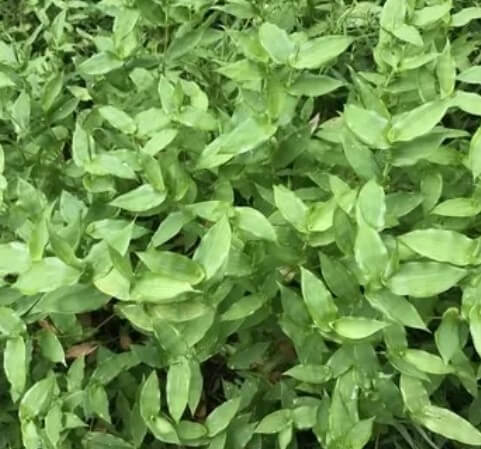[花園裡的詩篇3]
周朝女性時尚!
——赭黃+靛藍
朱嘉雯
[The Poems in the Garden 3]
Women’s Fashion in the Zhou Dynasty: Ochre + Indigo
by Prof. Zhu Jiawen
 菉
菉
面對《詩經》,我們幾乎可以提出所有的問題,而古人也都能給予回應,因為答案就隱藏在一首又一首的詩篇裡。
When reading the "Book of Odes and Hymns," the readers have any question, they would be satisfied with the answers provided in the book, for the solutions lie hidden within poem after poem. Let me give you some examples:
在沒有任何畫作、影像留存紀錄的情況下,我們如何勾勒一位周朝的鄉間女子,她的服裝形式,以及色澤質地呢?《詩經 . 小雅 . 采綠》中,是這樣說的:「終朝采綠,不盈一匊」。詩中女子所採之「綠」,就是菉蓐草,也稱為藎草。這種一年生的小草,遍佈於山野、水澤、溪澗之間,開著紫色或白色的小花,花莖非常纖細!可是啊,奧秘就藏在這纖細的花莖裡。因為這裡面帶有黃酮類化合物,下鍋煮一煮之後,竟然會出現非常鮮艷的赭黃色!因此成為棉、麻、絲、毛等面料的最佳染劑。最早是江漢平原一代的人們發現了這個化學變化,後來竟成了皇帝龍袍上刺繡的原料!可見這翠綠色小草能轉變為多麼明亮的鮮黃色啊!但是大家別誤會,皇帝身著黃袍的慣例,是唐、宋以後才慢慢成形的。因此在《詩經》的年代,鄉間女子之所以採「綠」草,實際上是期待青綠轉赭黃之後,能為自己的服裝增添色彩!
In the absence of any visual records, how can we depict the attire and textures of a rural woman from the Zhou Dynasty? In the poem “Gathering Grass” from the Minor Odes of the Kingdom in the "Book of Odes and Hymns", it says: "Throughout the day, I tried to gather grass for fabric dyeing, but could not fill a basket." The "grass" gathered by the woman in the poem refers to cattail, also known as bulrush. This annual grass grows abundantly in the mountains, waters, and streams, bearing small purple or white flowers on its delicate stems. However, the mystery lies within these slender stems. They contain flavonoids, and when boiled, they produce a remarkably bright ochre color! Thus, they become the optimal dye for fabrics like cotton, linen, silk, and wool. Initially discovered by the people of the Jianghan Plain, this chemical transformation eventually became the material for embroidery on imperial dragon robes! This illustrates how this verdant grass can transform into such a vibrant yellow hue! But don't misunderstand; the tradition of emperors wearing yellow robes gradually was formed during the Tang and Song Dynasties. Therefore, during the era of the "Book of Odes and Hymns," when rural women gathered "grass," they hoped that the verdant green would turn into a bright ochre, adding color to their clothing!
不僅如此,先秦時代女子時尚的顏色還有很漂亮的靛藍!在剛剛所引述的同一首詩裡,下一段即云:,「終朝采藍,不盈一襜」,此處的「藍」,就是蓼藍草。這種小草非常可愛,在橢圓形的葉面下長滿了絨毛,而秘密也就藏在這個葉面下了。原來這葉子含有尿藍母素,遇水分解之後,就會變成紫藍色。蓼藍草開著艷麗的紫紅小花,原產地在中南半島和中國,可是因為遇水之後竟然會轉化成鮮艷的亮藍色!因此聲名遠播,種子傳到了歐洲,隨即成為歐洲人藍染的主要植物。於是我們發現〈采綠〉這首詩裡的女子,之所以要採集這些植物,就是為了染出漂亮的布料,進而吸引她的情郎回到身邊來。
Moreover, the fashion colors for women in the pre-Qin period also included the beautiful indigo! In the same poem just quoted, the next line reads, "Throughout the day, I tried to gather grass for fabric dyeing, but I could not fill a sack." The "grass" mentioned here refers to woad, also known as Isatis indigotica. This type of grass is very charming, with its oval-shaped leaves covered in fuzz, and the secret lies beneath these leaves. It turns out that these leaves contain indican, which, when hydrolyzed by water, turns into a purple-blue color. Woad bears beautiful purple-red flowers and is native to the Indochina Peninsula and China. Because it transforms into a brilliant bright blue when exposed to water, its fame spread far and wide. Its seeds were introduced to Europe, where it soon became the primary plant for blue dyeing among Europeans. Therefore, we find that the woman in the poem "Gathering Greens" collects these plants not only to dye beautiful fabrics but also to attract her lover back to her.
因為接下來的詩句,講得很清楚:「之子於狩,言韔其弓。之子於釣,言綸之繩。」原來她的丈夫是個獵人,出門打獵已經五、六天了,眼看就要回來了,如果此時能染做鮮艷的布料,裁製美麗的衣裳,穿在自己的身上,丈夫從密樹叢林間回來,必定一眼就能瞧見她。因為她整個人是多麼的鮮亮嬌美啊!
Because the following lines make it clear: "The young man is out hunting, I set up the bow for him. The young man is out fishing, I stringed the fishing lines for him." It turns out her husband is a hunter, and he has been out hunting for five or six days now. He's about to return, and if she can dye vibrant fabrics and tailor beautiful clothes at this moment, wearing them when he returns from the dense forest, he will surely spot her at a glance because she will be so bright and beautiful!
而且我們幾乎可以斷定,這美麗的藍染是要拿來裁製裙子的。原因在於詩句中的:「不盈一襜」。「襜」是一種打褶子的短裙,又稱為「襜褕」。原來先秦時代的女子經常穿著通身又緊又窄,長襬曳地的深衣,為的是行不露足。但是有時為了工作方便,就會將裙子改為短版的六片裙,有點像是從腰部過膝蓋,圍了一圈的圍裙。這樣的小裙子,加在長版內裙之外,更增添俏麗!這麼亮眼的色澤!還有那層層環繞的款款裙擺,襯托出婀娜多姿的身段,我真替她焦急,她的情郎怎麼還不回來?
And we can almost draw the conclusion that this beautiful indigo dye is intended for making skirts. The reason lies in the line: "Not filling even a sack." "Sack" here refers to a pleated short skirt, also known as a "cuipao." It turns out that women in the pre-Qin period often wore the clothes that were tight and narrow, with long skirts that trailed on the ground to conceal their feet while walking. However, sometimes for convenience in work, they would shorten the skirt to a shorter version of a six-panel skirt, somewhat like a waist-length apron that extends past the knees. This type of skirt, worn over the long under-skirt, adds even more charm! Such a dazzling color and those layers of surrounding skirt edges accentuate her graceful figure. I can't help but feel anxious for her! Why hasn't her lover returned yet?


